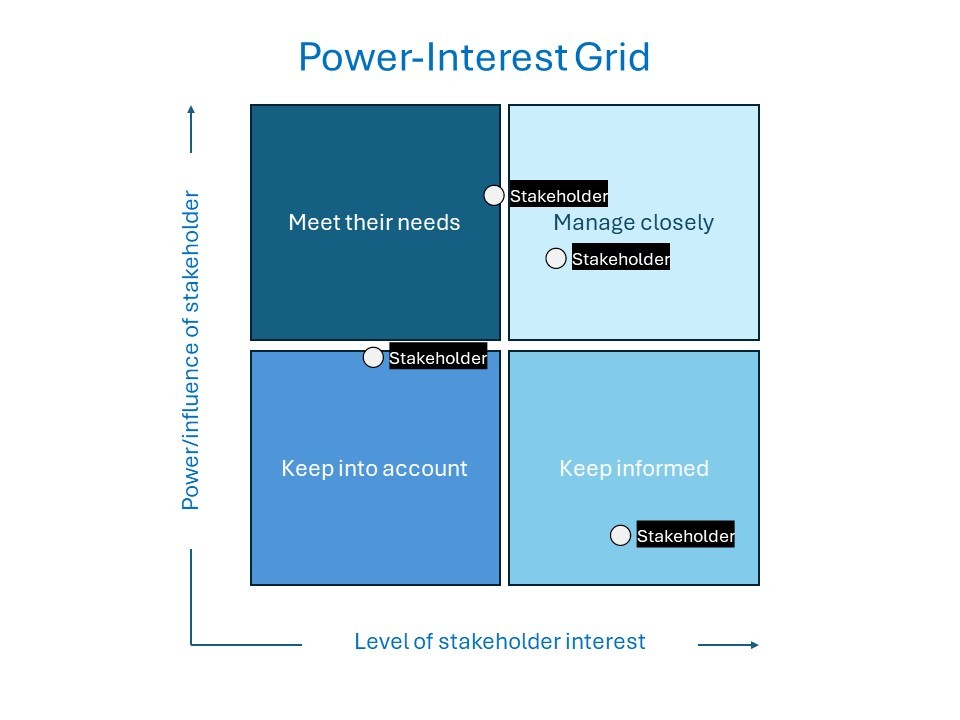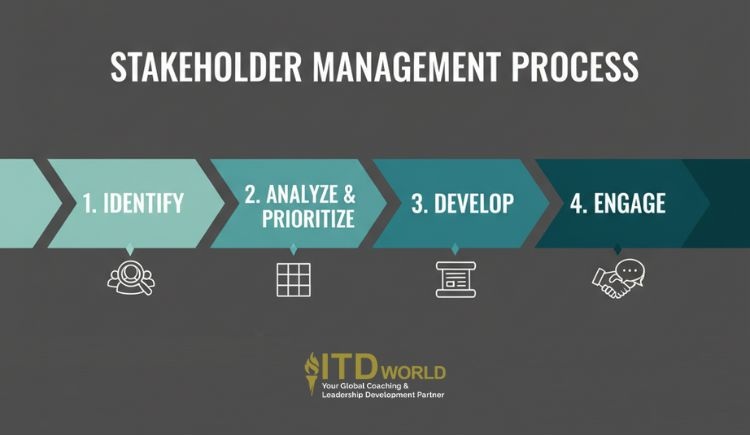A complete playbook for mastering stakeholder management, plus a practical 4-step process for implementation & navigating challenges.
We have all seen it happen: a brilliant project, backed by a talented team and a solid budget, grinds to a halt or fails upon delivery. The cause is rarely a technical failure. More often, it is a human one – a key group of stakeholders was ignored, their concerns were misunderstood, or their support was never earned. Stakeholder management is the essential leadership discipline designed to prevent this exact scenario. It provides a proactive framework for navigating the complex web of human interests that surrounds any significant business initiative, ensuring alignment and building the momentum needed for success.
|
Author: Jonathan M. Pham |
Highlights
- Stakeholder management is a systematic process of identifying, analyzing, and engaging with individuals or groups who can affect or be affected by an organization’s actions.
- Effective stakeholder management is crucial; it’s a strategic function that enhances project success, builds trust and reputation for leaders, and drives employee engagement during organizational change.
- The stakeholder management process involves a four-step guideline: identifying all relevant individuals and groups, analyzing and prioritizing them using a Power/Interest Grid, developing a tailored engagement and communication plan, and finally, engaging with them through proactive, two-way, honest, consistent, and tailored communication.
- Effective stakeholder management relies on strategic and adaptive communication, negotiation and influence to gain support, empathy and perspective-taking to understand diverse viewpoints, and strategic thinking to align individual interests with overall goals.
- Navigating common stakeholder challenges involves proactively addressing competing priorities by focusing on shared interests and tackling low engagement or persistent resistance by diagnosing the root cause and clearly articulating the “What’s In It For Them” (WIIFT).
- Success in stakeholder management is measured through a balanced approach that combines project-based metrics, such as reduced delays, budget overruns, and risks, with relationship-based metrics, including stakeholder satisfaction, fewer escalations, and increased active participation.
What is Stakeholder Management?
Stakeholder management is the systematic process an organization uses to identify any individual, group, or entity that can affect or be affected by its actions, and then to analyze their interests and plan strategies to engage with them effectively. While the concept has roots in earlier work, it gained prominence in strategic management in the 1980s, marking a critical shift from a narrow focus on shareholders to a broader understanding that long-term success depends on managing a complex ecosystem of relationships.
As mentioned, “stakeholder” and “shareholder” are two related terms; however, they are not interchangeable.
- Shareholders are individuals or institutions that own at least one share of a company’s stock, making them partial owners. Their primary interest is typically the financial return on their investment.
- Stakeholders represent a much broader category. A stakeholder is anybody with an interest or “stake” in the business’s operations, decisions, and outcomes.
The key takeaway is simple: all shareholders are stakeholders, but NOT all stakeholders are shareholders. An employee, a customer, or a local community group can have a powerful stake in your organization’s success without owning any stock. Effective leadership requires managing the interests of both.
Types of Stakeholders
To begin identifying these groups, it is helpful to categorize them based on their relationship with your organization. The two primary types are:
- Internal: These are individuals and groups operating within the business itself. Their interests are directly tied to the company’s performance and culture.
Examples: Employees, line managers, executives, and the board of directors.
- External: These refer to individuals, groups, or entities outside the organization that are nevertheless impacted by its decisions and actions.
Examples: Customers, suppliers, creditors, government agencies, regulatory bodies, trade unions, and the local community.
Why is Stakeholder Management Important?
Effective stakeholder management is far more than an administrative task or a simple exercise in communication; it is a core strategic function that directly contributes to organizational success. In an environment of increasing complexity and interdependence, the ability to effectively engage stakeholders is a powerful competitive advantage. The benefits are not abstract—they are tangible, measurable, and felt across every part of the business.

In project management: From risk to resilience
In the domain of project management, stakeholders can be a project’s greatest asset or its most significant risk. Proactive engagement is the key to ensuring they are the former.
The Project Management Institute (PMI) has consistently found that ineffective communication and poor stakeholder engagement are leading causes of project failure. One PMI report noted that 33% of projects fail because of a lack of involvement from senior management—a critical stakeholder group. Conversely, organizations that excel at stakeholder engagement see far better outcomes.
Example: Consider a large construction project. Without involving the local community (an external stakeholder), the project could face protests, legal challenges, and costly delays. On the other hand, by engaging them early—listening to their concerns, co-creating solutions for noise and traffic, and highlighting the benefits of local job creation—the project team transforms potential opponents into supporters, ensuring a smoother, more successful execution.
In general leadership: Building trust and reputation
For senior leaders, stakeholder management is synonymous with building trust and enhancing corporate reputation. In an economy where, according to HBR analyses, up to 80% of a company’s market value comes from intangible assets like brand equity and goodwill, trust is a priceless commodity. As a study from Deloitte shows, trustworthy companies is capable of outperforming their peers in market value by a significant margin.
Effective stakeholder management demonstrates that a company is accountable and transparent, which builds a strong reputation that attracts investors, partners, and customers.
Example: When a CEO is planning a major corporate restructuring, they must manage a wide array of stakeholders. A top-down, surprise announcement is likely to cause fear, rumors, and a drop in morale. An effective leader engages key department heads, employee representatives, and major investors beforehand. By communicating the “why” and listening to concerns, they build buy-in and trust, making the entire transition less disruptive and more successful.
Read more: Leadership Accountability – Key to Driving Results & Autonomy
In Human Resources: Driving engagement through change
For HR professionals, stakeholder management is central to employee relations and change management. During any significant organizational transformation initiative, employees are the most critical internal stakeholders. How they are managed directly impacts morale, productivity, and retention.
Research shows that when organizations use a collaborative or “open-source” strategy for change – involving team members in the process – employee engagement can increase by up to 38%.
Example: When implementing a new performance review system, a traditional HR department might simply design and launch it, potentially resulting in resistance and low adoption. A strategic HR team, on the other hand, treats their people as key stakeholders. They form focus groups, run surveys, and co-create the new system with employees and managers, ensuring the final product is seen as fair, relevant, and supportive of their growth – leading to much higher engagement and buy-in.
Read more: Employee Engagement in the Digital Age
Stakeholder Management Process: A Step-by-step Guideline
While every situation is unique, following a consistent process ensures that no critical group is overlooked and that your efforts are focused where they will have the most impact.
Below is a reliable framework for coming up with a clear and actionable plan.
-
Identify – Who needs to be considered?
The first step involves a comprehensive brainstorming exercise to identify every individual, group, or organization that has a stake in your project. It is crucial to think broadly at this stage, using the categories of internal and external stakeholders as a guide. Go beyond the obvious names and consider who will be impacted indirectly, who might perceive they are impacted, and who has the power to support or block your progress.
Actionable tip: Create a stakeholder register. This is a living document – often a simple spreadsheet – that lists each stakeholder you identify. At a minimum, it should include their name/group, role, and a brief note on their connection or initial interest in the project.
-
Analyze & prioritize – Where to focus your energy?
Once you have your list, it’s clear that you cannot give everyone the same level of attention. In other words, prioritization is essential – so that your time and resources may be spent effectively. The most widely used tool for this purpose is the Power/Interest Grid – a simple matrix that categorizes stakeholders based on two key dimensions:
- Power: Their level of authority or ability to influence the project’s outcome.
- Interest: Their level of concern or how much they are affected by the project’s outcome.
Mapping your stakeholders onto this grid places each one into one of four quadrants, which then dictates your engagement strategy:
- High Power / High Interest (Manage closely): These are your key players. You must fully engage with them, collaborate closely, and make every effort to satisfy their needs.
- High Power / Low Interest (Keep satisfied): This group has the power to block your project but isn’t interested in the daily details. Keep them satisfied with the overall progress, but don’t overwhelm them with excessive communication.
- Low Power / High Interest (Keep informed): These individuals or groups are passionate about the project but lack significant power. Keeping them informed with regular updates shows respect for their interest and can help turn them into valuable advocates.
- Low Power / Low Interest (Monitor): This group requires minimal effort. Monitor them periodically to ensure their level of interest or power doesn’t shift unexpectedly.

Stakeholder management model: Power/Interest Grid matrix
(Image source: Simply Stakeholders)
-
Develop – What is your engagement plan?
Now, it’s time to come up with a tailored engagement and communication plan – outlining how you will interact with the groups in each quadrant. It should define the purpose of your communication, the key messages you want to convey, the most appropriate channel, and the frequency of interaction.
Example: The plan for your “Manage Closely” group (e.g., the project sponsor) might include weekly one-on-one meetings and a seat on the project’s steering committee. In contrast, the plan for your “Keep Informed” group (e.g., the wider company staff) might consist of a monthly project update in the company newsletter.
-
Engage – Applying the principles of effective communication
The final step is about putting your plan into action. Effective engagement is driven by a set of core principles that build trust and facilitate productive relationships:
- Be proactive, not reactive: Initiate communication early and maintain a regular cadence. Don’t wait for problems to arise before you engage.
- Practice two-way communication: Engagement is about listening as much as it is about talking. Actively solicit feedback, ask questions, and show that you value the input you receive.
- Be honest and transparent: Build trust by being candid about project progress, including challenges and setbacks.
- Be consistent and reliable: If you promise a weekly update, deliver a weekly update. Reliability is a cornerstone of trust.
- Tailor your message: Adapt your communication style, tone, and level of detail to the specific stakeholder group you are addressing, as outlined in your plan.

Stakeholder Management Plan Template
Section 1: Project Overview
Before you begin, clearly define the initiative this plan is for.
Project / Initiative Name:
Project Leader / Owner:
Primary Goal of this Project / Initiative:
(What does success look like in one sentence?)
Step 1: IDENTIFY Your Stakeholders (The Stakeholder Register)
Use the table below to brainstorm and list every individual, group, or organization that could be affected by your project or have the power to influence it. Think broadly across both internal and external categories.
| Stakeholder (Name / Group) | Role / Title | Category (Internal / External) |
Initial Interest or Concern
|
| e.g., Jane Smith | CFO | Internal |
Project budget and ROI
|
| e.g., Marketing Team | Department | Internal |
Impact on upcoming campaigns
|
| e.g., Beta Testers | User Group | External |
Product usability and features
|
Step 2: ANALYZE & PRIORITIZE Your Stakeholders
Now, prioritize your stakeholders to focus your efforts where they matter most. For each stakeholder from your register, assess their level of Power (ability to influence the project) and Interest (how much they are affected by it) and place them in the appropriate quadrant.
| Low Interest | High Interest | |
| High Power | Keep Satisfied | Manage Closely |
| Low Power | Monitor |
Keep Informed |
Use the table below to map your stakeholders to the grid.
| Stakeholder Name | Power (High/Low) | Interest (High/Low) |
Quadrant / Engagement Level
|
| e.g., Jane Smith, CFO | High | High | Manage Closely |
| e.g., IT Security Dept | High | Low | Keep Satisfied |
| e.g., Beta Testers | Low | High | Keep Informed |
| e.g., Other Depts | Low | Low | Monitor |
Step 3 & 4: DEVELOP & ENGAGE (The Engagement Plan)
This is the core of your plan. Based on your analysis, detail how you will engage with your key stakeholders. Focus your most detailed efforts on the “Manage Closely” and “Keep Satisfied” groups.
| Stakeholder | Key Interest / Concern | Desired Outcome of Engagement | Key Messages | Engagement Method & Channel | Frequency | Owner |
| e.g., Jane Smith, CFO | Budget adherence and ROI. | Secure project funding approval and continued support. | Highlight financial benefits, risk mitigation, and progress against budget. | One-on-one meetings; formal steering committee reports. | Weekly check-in; Monthly report. | Project Lead |
| e.g., Beta Testers | Product usability; want their feedback to matter. | Gather valuable user feedback and create project advocates. | Acknowledge their input, show how their feedback is being used. | Dedicated online forum; bi-weekly feedback sessions. | As needed. |
Product Manager
|
Stakeholder Management Skills
- Strategic and adaptive communication
Far more than the ability to simply transmit information, it is the skill of tailoring your message, tone, and channel to resonate with each specific stakeholder. A master communicator understands that a high-level executive needs a different kind of update than a hands-on technical team.
Example: A skilled leader wouldn’t send a dense, 20-page technical report to a time-poor executive in the “Keep Satisfied” quadrant. Instead, they would provide a one-page executive summary focused on key business implications and ROI. The detailed report would be reserved for the technical team who needs to understand the specifics.
- Negotiation and influence
Often, you will need to gain the support of stakeholders over whom you have no formal authority. As such, it requires the ability to negotiate effectively—to understand their needs, articulate the value of your proposal from their perspective, and find common ground that leads to a “win-win” outcome. Influence, in this context, is the art of persuading others to support a course of action because they genuinely believe it is the right thing to do.
- Empathy and perspective-taking
Arguably the most critical skill in stakeholder management, it refers to the capacity to step outside of your own viewpoint and genuinely understand a stakeholder’s motivations, priorities, pressures, and definition of success. Empathy allows you to anticipate reactions, diagnose the root cause of resistance, and build the rapport necessary for a trusting relationship.
Example: Instead of viewing a department head’s reluctance to adopt a new process as simple obstructionism, a leader with empathy might uncover that the stakeholder is primarily concerned about the significant retraining burden on their already overworked team. Addressing this real concern – perhaps by offering dedicated training resources – is far more effective than simply pushing back against the resistance.
- Strategic thinking
Effective stakeholder management is not just about keeping people happy; it’s about aligning their interests with the project’s ultimate goals. Strategic thinking involves the ability to constantly connect stakeholder needs and requests back to the bigger picture. It enables a leader to make smart trade-offs, say “no” when necessary (and explain why), and ensure that all engagement efforts are purposeful and contribute to the overarching objectives of the initiative.

Principles of effective stakeholder management
Navigating Challenges & Difficult Stakeholders
Even with a flawless plan and excellent skills, no significant project is free from challenges. Stakeholders have competing priorities, limited resources, and different perspectives. The true test of a leader’s stakeholder management capability is not in avoiding these issues, but in navigating them with confidence. Understanding the most common challenges is the first step to proactively managing them.
Competing and contradictory priorities
Problem: You will inevitably face situations where what one group’s wants is in direct conflict with the needs of another. For example, the Finance department wants to reduce project costs, while the Marketing team insists on a new feature that will increase the budget.
Solution: Focus on shared interests. The key is to elevate the conversation from their conflicting positions (what they want) to their shared interests (why they want it). By finding a common, high-level goal, you can reframe the discussion from a battle to a collaborative problem-solving session.
Example: A skilled leader would bring both department heads together and say, “Our ultimate goal for this project is to increase market share by 5%. Let’s work backward from that objective. How can we create a high-impact marketing feature within a budget that still delivers a strong ROI?” This focuses both parties on the same strategic target.
Low engagement or persistent resistance
Problem: Some stakeholders may be completely disengaged, creating a risk that their silence is mistaken for agreement. Others may be openly resistant, actively working against your project’s progress.
Solution: Diagnose the “Why” and Articulate the “WIIFT”. Resistance and apathy are often symptoms of a deeper issue. Use your empathy skills to diagnose the root cause – are they overwhelmed with other work? Do they feel their concerns haven’t been heard? Do they fear the change your project will bring? Once you understand their perspective, you may clearly articulate the “What’s In It For Them” (WIIFT), linking the project’s success directly to a benefit they care about.
Example: If a stakeholder is resisting a new software rollout, you might explain, “I understand your concern about the time required for training. Our analysis shows that once implemented, this tool will save each member of your team approximately five hours per week on manual reporting, freeing them up for higher-value work.”
Spotlight: Strategies for engaging resistant individuals
When dealing with a particularly difficult individual stakeholder, a more targeted approach may be needed:
- Meet one-on-one: Group settings encourage people to “perform” or dig into their stated positions. A private, informal conversation allows you to build personal rapport, listen to their genuine concerns without an audience, and explore solutions in a less defensive environment.
- Stick to facts and data: If a stakeholder’s resistance is based on emotion or subjective opinion, ground the conversation in objective data. Presenting clear evidence about the business case, project metrics, or customer feedback can de-personalize the conflict and focus the discussion on the facts.
- Find a trusted ally: Sometimes, you are not the right messenger. If the resistant stakeholder has a long-standing, trusting relationship with another senior leader, it is highly effective to have that trusted ally champion the project and help address their specific concerns.
Read more: Business Process Transformation – Strategies for Success
How to Measure Success in Stakeholder Management
While some benefits of stakeholder management, like “goodwill” or “trust,” may seem intangible, its success can and should be assessed. Effective measurement not only justifies the time and resources invested but also provides crucial data for refining and improving your engagement strategies over time.
A balanced approach involves looking at both quantitative project metrics and qualitative relationship metrics to get a complete picture.
- Project-based metrics: The impact on outcomes
These refer to the “hard” data that directly connects effective stakeholder engagement to project and business success. They are often the most compelling indicators for senior leadership.
-
- Project timelines and budgets: One of the clearest signs of success is a reduction in unforeseen delays and budget overruns caused by stakeholder issues. When stakeholders are properly engaged from the start, there are fewer last-minute change requests and roadblocks.
Example: You can track the “Number of project days lost due to stakeholder-related conflicts” or the “Percentage of change requests submitted after the planning phase” and aim to reduce these numbers on future projects.
-
- Risk reduction: A successful strategy will identify and address potential issues before they escalate.
Example: You can measure success by tracking a decrease in the number of items on your project’s risk register that are labeled as “stakeholder-related,” demonstrating that potential conflicts are being resolved early.
-
- Achievement of project goals: Ultimately, the goal is success. Effective stakeholder management ensures that the definition of success is clear, shared, and supported by all key parties, dramatically increasing the likelihood that the project’s objectives will be met.
- Relationship-based metrics: Gauging the quality of engagement
This category includes the more “qualitative” data that assesses the health and strength of your relationships with stakeholders. These are typically leading indicators of future project success.
-
- Stakeholder satisfaction surveys: The most direct way to measure engagement is to ask. At key project milestones, you may deploy a short, simple survey to your key stakeholders. Ask them to rate their satisfaction (on a scale of 1-5) with the clarity, frequency, and quality of communication, as well as how much they feel their perspective is being heard and considered.
- Reduced number of escalations: A significant drop in the number of stakeholder complaints or issues being escalated to senior leadership is a clear sign that your engagement strategies at the project level are working effectively.
- Level of active participation: Engagement can be measured by observing behavior. Are key stakeholders consistently attending important meetings? Are they actively contributing ideas and solutions rather than passively listening? A noticeable shift from passive attendance to active advocacy for the project is a potent indicator of success.
By combining the above-mentioned hard project metrics with qualitative relationship data, leaders are better equipped to build a comprehensive and compelling picture of their stakeholder management effectiveness, proving its value and guiding future efforts.

Level Up Your Stakeholder Management Effectiveness With ITD World’s Training Solutions
As we’ve seen, effective stakeholder management is far more than something simple; it is a critical leadership capability that drives project success, builds trust, and enhances organizational reputation. Mastering the process and skills to turn potential friction into strategic alignment is what separates good leaders from great ones. This journey of mastery is often accelerated with expert guidance and targeted development.
At ITD World, we specialize in equipping leaders and their organizations with the proven frameworks and competencies needed to excel at stakeholder engagement. Our programs are designed to transform this complex discipline into a practical, manageable, and highly effective part of your leadership toolkit.
We offer a range of solutions to meet your specific needs:
- Public workshops: Ideal for individuals and teams looking to build foundational capabilities in the core skills of stakeholder management, including strategic communication, negotiation, and influence.
- Certificate programs: Designed for HR professionals, project managers, and business leaders who require a deeper level of expertise and a formal qualification in advanced engagement and management strategies.
- Customized in-house solutions: We partner with your organization to design and deliver bespoke programs tailored to your unique industry, culture, and specific stakeholder challenges, helping you build a consistent, enterprise-wide capability.
Ready to turn your most complex stakeholder challenges into your greatest strategic assets? Contact ITD World today for a comprehensive consultation.
Other resources you might be interested in:
- 12 Golden Leadership Principles for Attaining Excellence
- Leadership Excellence: Moving From Manager to Multiplier
- Future Ready Organization: 11 Tips to Building One

